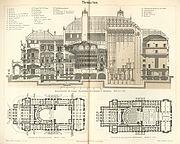
Hungarian State Opera House
Encyclopedia
.jpg)

Opera house
An opera house is a theatre building used for opera performances that consists of a stage, an orchestra pit, audience seating, and backstage facilities for costumes and set building...
located in central Budapest
Budapest
Budapest is the capital of Hungary. As the largest city of Hungary, it is the country's principal political, cultural, commercial, industrial, and transportation centre. In 2011, Budapest had 1,733,685 inhabitants, down from its 1989 peak of 2,113,645 due to suburbanization. The Budapest Commuter...
, on Andrássy út. It is home to the Budapest Opera Ball
Budapest Opera Ball
The Budapest Opera Ball is an annual Hungarian society event taking place in the building of the Budapest Opera on the last Saturday of the carnival season, usually late February. On this occasion the stage and the auditorium of the Opera is transformed into a huge ballroom...
, a society event dating back to 1886.
History
Designed by Miklós YblMiklós Ybl
Miklós Ybl was one of Europe's leading architects in the mid to late nineteenth century as well as Hungary's most influential architect during his career...
, a major figure of 19th century Hungarian architecture, the construction lasted from 1875 to 1884 and was funded by the city of Budapest and by Emperor Franz Joseph of Austria-Hungary. The Hungarian Royal Opera House (as it was known then) opened to the public on the September 27, 1884.
Many important artists were guests here including Gustav Mahler
Gustav Mahler
Gustav Mahler was a late-Romantic Austrian composer and one of the leading conductors of his generation. He was born in the village of Kalischt, Bohemia, in what was then Austria-Hungary, now Kaliště in the Czech Republic...
the composer who was director in Budapest from 1887 to 1891 and Otto Klemperer
Otto Klemperer
Otto Klemperer was a German conductor and composer. He is widely regarded as one of the leading conductors of the 20th century.-Biography:Otto Klemperer was born in Breslau, Silesia Province, then in Germany...
who was music director for three years from 1947 to 1950.
In the 1970s the state of the building prompted the Hungarian State to order a major renovation which eventually began in 1980 and lasted till 1984. The reopening was held exactly 100 years after the original opening, on the September 27, 1984.
Overview
It is a richly-decorated building and is considered one of the architect's masterpieces. It was built in neo-RenaissanceNeo-Renaissance
Renaissance Revival is an all-encompassing designation that covers many 19th century architectural revival styles which were neither Grecian nor Gothic but which instead drew inspiration from a wide range of classicizing Italian modes...
style, with elements of baroque. Ornamentation includes paintings and sculptures by leading figures of Hungarian art of the time including Bertalan Székely
Bertalan Székely
Bertalan Székely was a Hungarian Romantic painter of historical themes. "The Discovery of Louis II's Dead Body", "Women of Eger", "Battle of Mohács", "Ladislas V" are among the most important of his historical paintings. Szekely is also known for his many murals.-External links:* *...
, Mór Than
Mór Than
Mór Than was a Hungarian painter.Born at Bečej, he was educated in Italy and Vienna beside his cooperation with similar famous painters in his homeland. He worked in a realistic – pre-impressionist style. His subjects were mostly historic events and portraits but also mythological or...
and Károly Lotz
Károly Lotz
Lotz Károly Antal Pál, or Karl Anton Paul Lotz was a German-Hungarian painter.- Career :Karl Lotz was born in Bad Homburg vor der Höhe, Germany, the 7th and youngest surviving child of Wilhelm Christian Lotz and Antonia Höfflick ...
. Although in size and capacity it is not among the greatest, in beauty and the quality of acoustics the Budapest Opera House is considered to be amongst the first few opera houses in the world.
The auditorium holds 1261 seats. It is horseshoe shaped and – according to measurements done in the 1970s by a group of international engineers – has the 3rd best acoustics in Europe after La Scala in Milan and the Palais Garnier in Paris. Although many opera houses have been built since, the Budapest Opera House is still among the best in terms of the acoustics.
In front of the building are statues of Ferenc Erkel, composer of the Hungarian national anthem
Himnusz
"Himnusz" is a song beginning with the words Isten, áldd meg a magyart that's a musical poetic prayer that serves as the official national anthem of Hungary. True to its title, Himnusz presents a more solemn and dignified tone than many other lively national anthems...
, and the first music director of the Opera House. He was also founder of the Budapest Philharmonic Orchestra. The other statue is of Franz Liszt
Franz Liszt
Franz Liszt ; ), was a 19th-century Hungarian composer, pianist, conductor, and teacher.Liszt became renowned in Europe during the nineteenth century for his virtuosic skill as a pianist. He was said by his contemporaries to have been the most technically advanced pianist of his age...
, the best known Hungarian composer.
Each year the season lasts from September to the end of June and besides opera performances the Opera House is home to the Hungarian National Ballet.

Erkel Theatre
The Erkel Theatre was a theatre in Budapest, Hungary. Being the largest public building in the city for decades , it was made part of the Hungarian State Opera House in 1951...
. It is a much larger building that also hosts opera and ballet performances during the opera season.
There are guided tours in the building in six languages (English, German, Spanish, French, Italian and Hungarian) almost every day.

